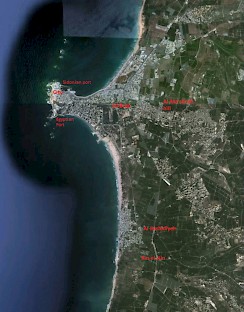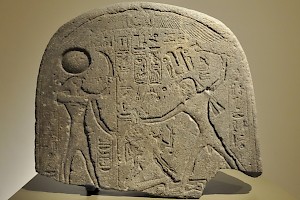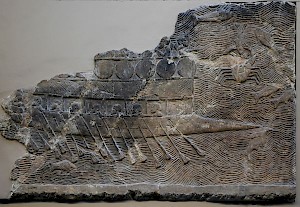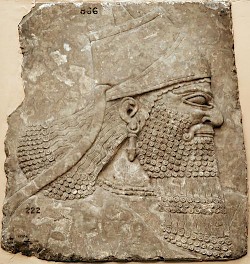Tyre
Q3991738Tyre (Phoenician צר, ṣūr, "rock"; Greek Τύρος; Latin Tyrus): port in Phoenicia and one of the main cities in the eastern Mediterranean.
Origins

Tyre was one of the most important cities in the ancient Near East. Built on an island in the eastern Mediterranean, it controled two natural harbors. It was sufficiently close to the shore to be supplied from its hinterland, but sufficiently far enough from the mainland to be nearly impossible to capture.
It was larger than the area that is now occupied by the Old City; parts have been swallowed by the sea. The ancient city also controled a fertile coastal strip, some two kilometers wide, with several minor towns, sanctuaries, and farms. On the shores were the villages of shell collectors, in the east was an occupied hill named Al Ma'shook, and near Al-Rashidiyeh in the south was a very old town, which is probably identical to the Ušu mentioned in Assyrian texts, and the Palaityros, "Old Tyre", of our Greek sources. This was, according to Arrian, the site of a very ancient sanctuary of Heracles (the Greek name of Melqart),note and archaeologists have found several Bronze Age tombs over here.
There were two sources near Ušu: one at Al-Rashidiyeh itself and the other a bit further south, at Ras el-Ain ("head of the source"). A third source was at Al-Bagbog, north of Tyre. So, the area was rich in water, and in Antiquity, this meant that there was a base for great agricultural prosperity.
The Bronze Age
In the mid-fifth century BCE, the Greek researcher Herodotus of Halicarnassus visited Tyre, spoke to a priest, and learned that the town and the temple of Melqart were, at that time, believed to be 2,300 years old.note In other words, the city was founded in the twenty-eighth century. This is more or less confirmed by archaeological finds on the Al Ma'shook hill, which are even older.
In the second millennium, Tyre is mentioned several times in the Amarna Letters. For example, king Abimilki asks Egyptian support in a conflict with Sidon. The shrine of the goddess Aširat (or Asherah) in Tyre is mentioned in the Epic of King Keret,note which is known from Ugarit. Letters from the same town show that the inhabitants were interested in Tyrian textiles. No doubt, purple played a role, the product for which Tyre was well-known.

Tyre is mentioned in a list of places from the reign of the Egyptian king Sety I (r.1293-1279), while a stela has been found in Tyre that commemorates a victory by Sety's son and successor Ramesses II (r.1279-1213). The region was barely touched during the crisis that is commonly associated with the arrival of the "Sea People", making the Phoenician cities full of confidence. This is illustrated by the Story of Wen-Amun, the ill-fated Egyptian diplomat who, at the end of the twelfth century, was sent out to buy lumber in Byblos. He mentions Tyre in passing.
King Hiram
At the beginning of the Iron Age, Tyre replaced Sidon as the most important city in the region. There is no doubt about that. It is also certain that the new leading city played a very important role in the Phoenician colonization movement. Tyre is mentioned as founder of Kition on the copper island Cyprus, of Carthage, Utica, and Lixus, and of Gades in Andalusia. The Roman author Pliny the Elder mentions Tyre as mother town of Lepcis Magna, but this is probably a mistake.note
What is less certain, is what or who caused these successes. Modern historians often refer to the Tyrian kings Abiba'al and Hiram, who probably lived in the tenth century BCE. The problem is that the main evidence for their activities can be found in the Bible, especially the books of Samuel and Kings, and in sources that are derived from the Biblical account. The general impression is that Hiram had good relations with king David and king Solomon, helped building Jerusalem's temple and palace, and contributed to naval expeditions.
The Jewish author Flavius Josephus already understood the problem: although he loved the Bible, he realized that non-Jews might reasonably ask questions about its reliability. Therefore, when Josephus wrote his Jewish Antiquities, he supported the Biblical account with quotes from one Menander of Ephesus, who claimed to have studied Tyrian sources. This Menander not only confirmed the Biblical account, but also added some bits and pieces: for instance, that Hiram promoted the cult of Melqart/Heracles (text). This appears to have been a real religious revolution.

The problem is still with us today. It is far from clear how much the author(s) of Samuel and Kings knew about the Early Iron age - this is the debate about minimalism and maximalism - and we cannot establish how reliable Menander of Ephesus was. So, we do not really know how important king Hiram was. It is likely that he was, like king Solomon, a really existing person, but some of his deeds may be legendary.
However this may be, it is a fact that Tyre became an important city, and it is also certain that in the Iron Age, old gods like Aširat/Asherah were less important than Melqart.
Assyria
The colonization movement was stimulated by external pressure. From the northeast, Tyre and the other Phoenician cities were threatened by the Assyrians. In order to buy them off, Tyre needed to obtain precious articles from the west. Of course, its prosperity made the city attractive to attack, but the island could not be captured. This created a situation in which Tyre flourished, expanded its influence to the western colonies, but was often watched its possessions on the land being looted and pillaged. An Assyrian king would boast that he had defeated Tyre, and after some time, more peaceful conditions arose, allowing Assyro-Tyrian trade to flourish. So, in both war and peace, Assyria benefitted from Tyre's trade network.
We can see both approaches during the reign of the Assyrian king Aššurnasirpal II (r.883-859). According to the text published as ANET3 276, he reached the Mediterranean, and accepted tribute from the coastal cities, including Tyre, where the people understood that they had to pay or face their land being looted. Later, more peaceful conditions returned, and Aššurnasirpal invited his subject kings to be present when he inaugurated his palace at Kalhu (Nimrud).note

Probably, the Tyrian guest was king Ithoba'al I, whose reign was, according to Menander of Ephesus, also remembered for a great famine. The Bible mentions him as the father of Jezebel, the wife of king Ahab of Israel. This versenote calls "Ethbaal" king of Sidon, and is not the only piece of evidence suggesting that the two cities were at times united in a personal union. This would be a necessary precondition is Tyre was indeed, as Menander of Ephesus states, the mother city of Bathrun and the (unidentified) Libyan city of Auza (text).
Aššurnasirpal's son and successor Šalmaneser III (r.858-824) fought a big war against the towns west of the Euphrates. A coalition, led by Damascus (but not including Ithoba'al of Tyre), came close to victory at Qarqar (853), but in 841, the Assyrians were sufficiently in control of the situation to isolate Damascus, and demand tribute from Israel, Sidon, and Tyre. This is described in the text called ANET3 280 and shown on the Balawat Gate. According to the Black Obelisk, Šalmaneser insisted on receiving tribute again in 838. Although the tributes must have been quite heavy, Tyre was capable of founding Carthage, and although story (text) says that there was a conflict between the colonists and the government, relations soon improved - if the story about the refugees is not a piece of fiction.

The next to insist on tribute was king Adad-Nirari III (r.811-783). The Tell al-Rimah Stela and the Nimrud Slab record tributes paid at the beginning of the eighth century. In his Annals, Tiglath-pileser III (r. 745-727) mentions that he received tribute on at least two occasions. From his successor, Šalmaneser V (r.726-722), few texts survive, but if we are to believe the report by Menander of Ephesus, the Tyrian ruler Lulli/Eulaeus was faced with a revolt in the colony of Kition and found himself besieged by the Assyrians. Menander's account of the Assyrians trying to deny the Tyrians access to fresh water, looks as if the enemy for the first time tried to capture the island. The outcome of the siege is not recorded, but it is likely that the Tyrians paid another tribute.
A bit later, we find king Lulli as ruler of Sidon, which again confirms that both cities were at times united in a personal union. According to the Sennacherib Prism, the Assyrian king Sennacherib campaigned in Lulli's lands prior to his famous advance to Lachish and Jerusalem in Judah (701 BCE). The Assyrian conquered Sidon and subjected it to a regular system of taxation. If his list of looted towns is correct, Tyre's territories still included Sarepta, Akzib, and Acre.
In spite of the loss of Sidon and Kition, Tyre recovered from Sennacherib's looting and pillaging, because a generation later, it could support king Esarhaddon of Assyria (r.680-669) when he suppressed a revolt in Sidon (677/676; mentioned in the Esarhaddon Chronicle). From the text known as Prism B, we learn that in 676/675, Esarhaddon ordered the kings of the land west of the Euphrates to participate in a project in Nineveh. Later, the Assyrian king concluded a treaty with king Ba'al I of Tyre, in which Tyre's sphere of influence was recognized but the king had to accept that there was a permanent Assyrian official at his court.

For Esarhaddon, it was important to prove that he was in control, because the area was of great strategic importance if he wanted to attack Egypt. It is possible that the Sidonian revolt had been caused by Egyptian agents, and even if this was not actually the case, the coastal cities were easy to reach for Egyptian visitors. The war broke out in the spring of 674, and an Assyrian chronicle admits that Esarhaddon was defeated.note The same source mentions that three years later, the Assyrians had more success.note On stelas found in Zincirli and the Nahr al-Kalb, Esarhaddon also boasts about his glorious achievements.
However, in the meantime, pharaoh Taharqo (r. c.690-664) had been able to incite revolts in Esarhaddon's rear, and the Assyrian king was forced to punish Ashkelon and Tyre. This seems to have happened in the first weeks of 671, before the second attack on Egypt. Again, the island city was not captured: it was too far from the coast and the army was in a hurry. Nevertheless, Esarhaddon had shown his teeth, and could continue to Egypt.

However, the situation remained uneasy. Esarhaddon's son and successor Aššurbanipal (r.669-631?) was as unsuccessful as his father: in his third year, he managed to occupy the mainland, but he was unable to capture the city itself. From Aššurbanipal's own account, the usual boast of an Assyrian kings, the list of tribute received, is absent; it seems that a marital alliance was concluded. Kition appears to have returned to Tyre's sphere of influence. Still, mutual relations continued to oscillate between cooperation and war.
The main point is that capturing Tyre was not in the Assyrian interest. It was more lucrative to every now and then seize the mainland and demand tribute, and continue to benefit indirectly from Tyre's international trade, than to curtail the city's freedom. Although our sources give a very different impression, Assyria's policy was in fact far from hostile. It sheared its sheep, but did not skin them.